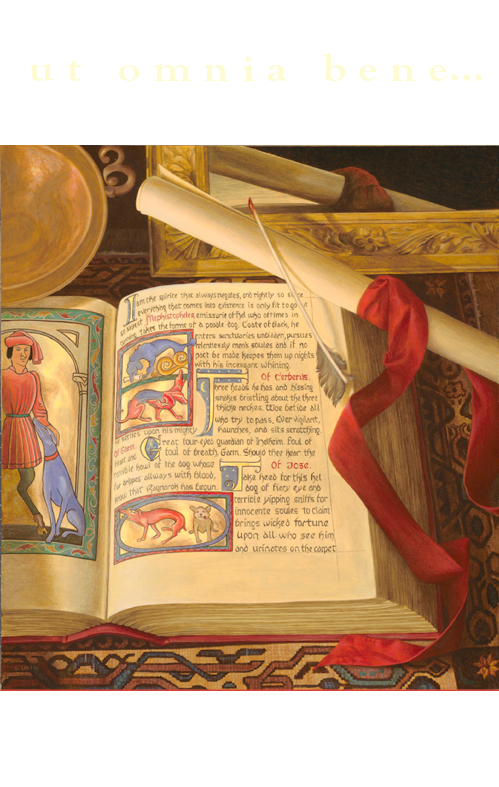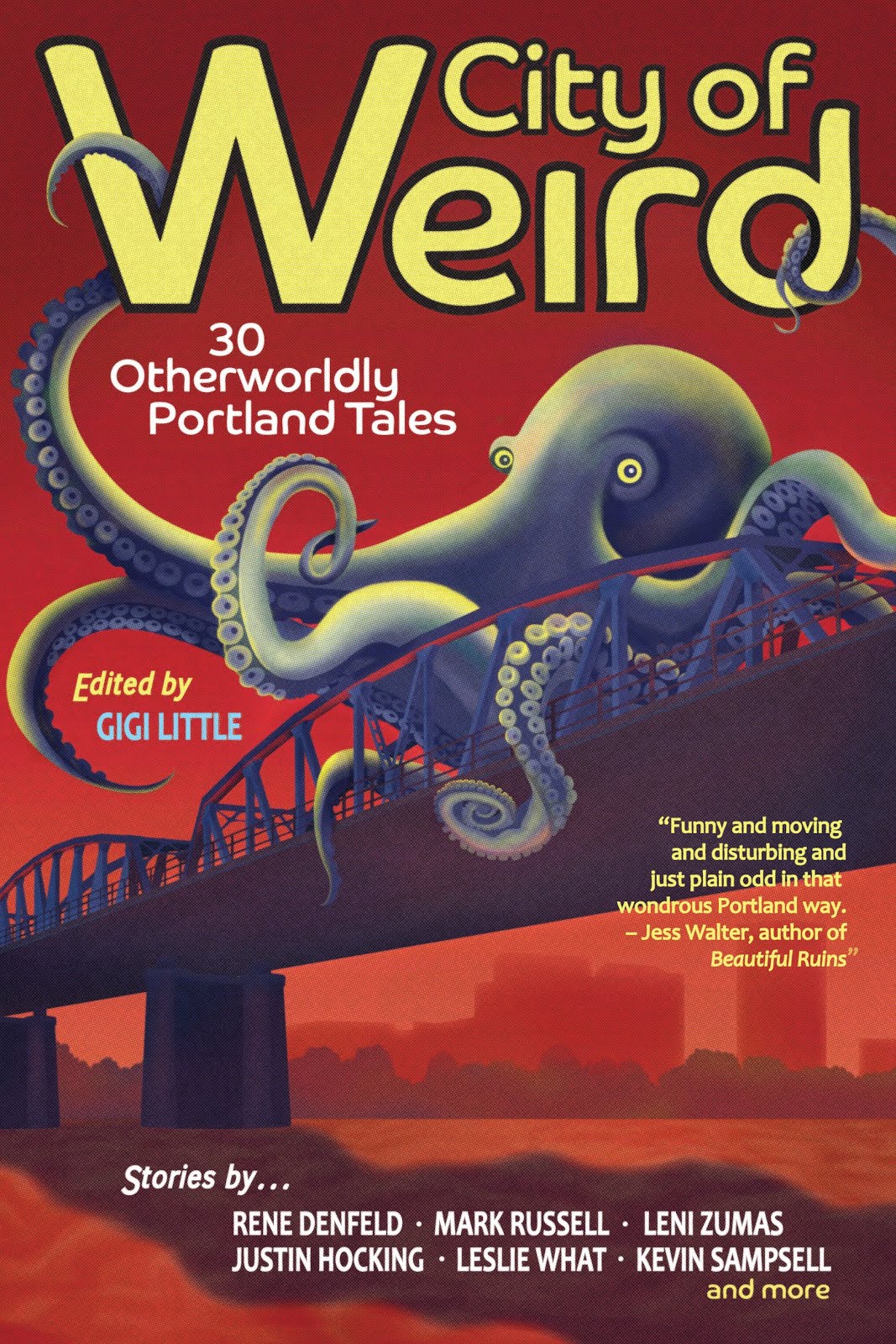Last November, Forest Avenue Press did a cover release for our next anthology, Dispatches from Anarres: Tales in Tribute to Ursula K. Le Guin, conceived and edited by Susan DeFreitas. Then in January, we got feedback from our distributor, Publishers Group West, that they were concerned the cover skewed too sci-fi.
My original concept, when I first started sending out early samples, had been ALL-SCI-FI-ALL-THE-TIME: a huge silver interplanetary communicator shooting out into space. Susan had brought me back to earth a bit by reminding me that Le Guin's works are equally divided between science fiction and fantasy—and that our collection Dispatches from Anarres is as well. To add that fantasy element, she had the cool idea of filling the sky with the silhouettes of flying dragons.
When in January our representatives at PGW brought up their own too-much-sci-fi concern, we said,
hey, but dragons, and they said,
what dragons?, and we were like,
what do you mean, what dragons?, but it was true: when viewed in any smaller-form that more subtle element did kind of disappear.
So I set out to find a way to get those dragons to stand out more without making the cover too busy in the process. We were getting pretty late in the game to be tinkering with the cover, but it was important to get it right. I was playing with color and brightness and contrast when I started...
...to have second thoughts.
About the whole thing.
PGW's concerns, Susan's early concerns, what if I was getting this thing all wrong?
In an email to Forest Avenue Press publisher Laura Stanfill in which we were discussing little changes like font sizes, I snuck in:
There's also part of me that is wondering... is this cover right? Are we getting the Le Guin right? Should it be an alien landscape instead?
Because Le Guin was always more focused on the natural world than technology, even in her sci-fi writings. One of the representatives at PGW had called her work nature writing. And a lot of her own book covers reflect that.
As soon as I wrote that what if to Laura—what if I'd been getting it wrong all along—I knew I was right.
You might think, um, what are you thinking, deciding to go completely back to the drawing board so late in the process, I mean, what are you going to do, conjure up an alien landscape like magic?
Well, yes. That's what I was going to do.
It just so happens I have a brother who creates alien landscapes.
Ever since he was a kid, my brother Frank Little has been creating and refining a world. A specific world all his own, with maps he drew, stories he wrote, words in different languages, king lists for dynasties of rule. As he became an adult, that obsession drew him to learn computer modeling programs.
Look at this!
And this!
What would you do if this thing cropped up in your backyard?
You can't really see the detail on these because of the thin format of my blog, which I'd change but I'm afraid it'll throw off the layout of sooo many posts so I always leave it alone... but you can check out more of his work on DeviantArt here or on his website here.
The night after I wrote that what-if note to Laura, I started scrolling through his artwork, hoping I might find something that would work. When I came across this, I had one of those visceral moments: I knew it was perfect.
Anarres, the inhabited moon in Le Guin's book The Dispossessed, is a barren desert of a place, with very little animal and plantlife. We didn't expressly need the setting of the book cover to be Anarres, but it was important that it not not be Anarres, if that makes sense. Not only did the terrain in Frank's "Hanging Artichoke" feel right, I could already picture what I would do with it. I imagined a whole bunch more sky above the cliff (I could add that in) and a woman standing on the edge looking out over the desert vista as if awaiting word from those Dispatches that had been sent from her world to the next.
I wondered if Frank would be okay with me... getting my fingers into his artwork. Adding more sky. Tossing a woman onto his mountaintop. When I texted to ask about it, he said, referencing Le Guin, "Well since I recently reread all of her stuff I would love to have one of my pictures involved..."
It was strange to go back to square one and reposition the text after I'd gotten so used to looking at the layout of the original book cover. This new approach and new artwork wanted a completely new layout, new colors, new fonts. When I sent Laura my first [new] draft, I punned, "This is soooo different from what we had before. It's like night and day. Get it?"
I played around with slight variations on text and placement. For some I added a little more sun in the sky—and even a silhouette of one of Susan's dragons.
But dragons don't exist on Anarres (birds don't even exist on Anarres), so we chucked the dragon and packaged up the sample we thought was the best of the batch, Laura and me, and sent it Susan's way.
(Please don't notice how many times I miscapitalized Le Guin above. I knew how to spell it. I knew. But somehow I goofed.)
It was so important to both of us that Susan like the cover of the book she'd conceived. And it was so important that PGW think it was a cover that would sell the book. So many considerations go into the creation of a book cover, and I realized, as I worked on this one, that we had more people we wanted to please than ever before.
There was the editor and the distributor, there was the publisher and the cover designer (I like liking things). There was Frank whose artwork I was using. There were alllll the authors who'd written stories for the book. But even beyond this, there was the legacy of Ursula K. Le Guin. Her memory, her family, her legion of fans.
Eek, that's a lot of people.
We started to get feedback. PGW loved it. For Susan, it wasn't sci-fi enough, didn't tell enough story. My brother joked, "Ok yeah that's the coolest thing I've ever seen." Laura then sent the sample to a couple Le Guin experts, one being our copy editor Bailey Potter, and her feedback: women on Anarres don't wear dresses.
Oops.
To Susan's concerns about the amount of sci-fi, I thought, OK, this new cover, that was like night and day to the old cover, I think it needs to go back to night.
Or maybe...
What if instead of the light blue of day or the deep blue of night we take a left turn into red?
And added, in that red sky, the planet to Anarres' moon: Urras.
A la:
I started by getting my fingers even deeper into Frank's artwork. With his blessing, I cut the sky out around his cliff and hanging artichoke. I made two overlapping files, one that was just cliff-artichoke and one that contained the desert vista. The biggest challenge working with the artwork was darkening that vista and getting those colors to fade nicely up into the sky color.
Then I built a planet. That took a while. Planets are big. I also worked longer than you want to know to build a new outfit for my woman, with lots of feedback from Susan, Laura, and our two Ursula K. Le Guin experts, writer Sarah Cypher and our copy-editor Bailey Potter. The planet was built mostly in Illustrator, the woman in Paint Shop Pro. I added stars the the sky. I took them out again. I know I'm grossly oversimplifying this part of the process, but heck, this blog post is already the size of the indefinable fathoms between here and Anarres. In the end, Laura shared with me that Susan said:
"This image feels—almost like someone contemplating the cosmos, other civilizations—or like someone standing on another planet contemplating Earth. That feels like the story implied by this image, and it could not be more perfect."
Ah! That felt good.
(Stand-in blurb, notwithstanding. That, as always, will be updated down the line.)
Dispatches from Anarres will be published by Forest Avenue Press this coming November, with stories from (big breath) TJ Acena, Kesha Ajọsẹ-Fisher, Stevan Allred, Jason Arias, Stewart C. Baker, Jonah Barrett, Curtis Chen, Tina Connolly, Mo Daviau, Rene Denfeld, Molly Gloss, Rachael K. Jones, Michelle Ruiz Keil, Juhea Kim, Jessie Kwak, Jason LaPier. Fonda Lee, David D. Levine, um me, Sonia Orin Lyris, Tracy Manaster, James Mapes, C.A. McDonald, Tim O’Leary, Ben Parzybok, Nicole Rosevear, Arwen Spicer, Lidia Yuknavitch and Leni Zumas, and with a foreword by David Naimon.
More information is here. More on editor (and writer) Susan DeFreitas is here. Big thanks to Frank Little for his art, and to Susan, Laura, the folks at PGW, and our LeGuin specialists Bailey Potter and Sarah Cypher for all their input.
Here's a sneak peek story snippet for you. From "Each Cool Silver Orb a Gift" by Nicole Rosevear
*
Helena had not yet been born when the long war, the last war, began, but she had been in the Southlake settlement from its beginning, providing her unfocused childhood labor to the construction of communal households, dining and medical facilities, gathering spaces, and gardens. Over decades, she had moved her way through the full set of work cycles, adding her name to the lottery of women eligible to sit on the Council late in her fourth decade, knowing the chances of being drawn were slim. She did not need that particular honor to hold a deep pride in her small part in the building of Southlake, this newly gentled world, made better for all by the ruling hands of women.
When Sasha, the last remaining member of the original Council, added her name to the list of those withdrawing from the work cycles, Helena attended the lottery, excited to witness the drawing of a new member, a rare and momentous event. The afternoon was cool and muggy, the hazy sun unable to break through the clouds. When the name was drawn and called, she did not recognize it as her own, looking around at the women, men, and thirds gathered in the main square for this other Helena. When she realized others were looking back at her rather than past her, that she was that Helena, she cried out in surprise. To step into the shoes of one of the original Council members was an honor she had not dreamed of.
Walking back to her household, the flurry of conversations and introductions already a blur, the metal of her new Council pin cool against her throat, Helena passed a group of three men and two thirds in an alcove near a dining hall. She heard the tail end of a hissed whisper, one of the thirds saying, “. . . their pawns to being yours.” When they saw her approaching, the man directly facing her tapped his collarbone twice, near the spot Council members wore their pins. The group turned quickly away from each other, one of the thirds offering her a casual open-handed greeting.
“Afternoon,” she said, returning the gesture. It seemed that they did not want her to have heard them, and it was easy enough to imagine she hadn’t.













































